LED strip is a kind of the lamp of the same name, which looks like a flexible plastic base with dotted elements placed on it. Such illuminators are used for decorative illumination of buildings and other objects, but are often used as an internal light source. In addition, RGB lighting for interiors is a versatile tool that allows you to get original lighting effects. RGB LED strip comes on sale in standard plastic spools.
Types of RGB tapes and their differences
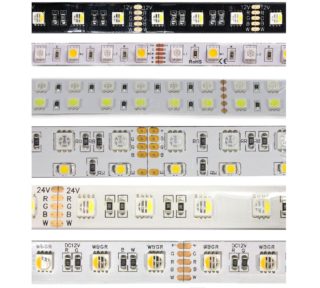
There are several types of LED strips:
- monochrome - they are also called monochrome;
- colored or RGB: stands for red, blue, green;
- with large or small LEDs.
It is possible to distinguish a single-color LED strip from RGB according to the description by the number of conductors supplied to it. There are only two of them on a monochrome product, and four on a color one.
To connect a single-color tape, one power supply is enough, and for its RGB analogue to work, an additional controller is required.
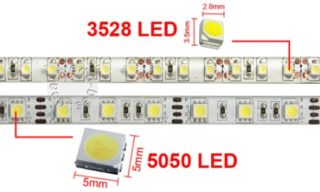
By the type and size of LEDs, this type of illuminator is subdivided into specially marked samples:
- SMD3528 and SMD5050 are the most popular types of LED strips;
- SMD2835 and SMD5630 (or 5730) are less common models.
To understand the above designation, it is important to know that SMD comes from the English Surface Mounted Device. In translation, this means - a device for surface mounting. With this technology, LEDs are placed on the top plane of the substrate.
Characteristics of RGB tapes
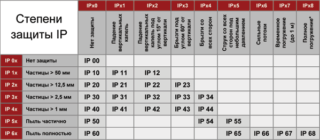
RGB lighting for indoor and outdoor spaces (rooms and building facades) is a proven decoration technique. To take advantage of these benefits and implement the desired effects, you will need to become familiar with the characteristics of LED illuminators. The main parameters that must be taken into account when choosing a tape:
- the level of illumination generated by the product;
- the type of LEDs used;
- density of their placement on the surface of the tape and color;
- degree of protection against external influences (IP);
- types of power supply and control of RGB lighting.
Luminosity
This parameter is calculated for a one meter piece of LED strip and is measured in lumens. It is completely determined by the type of LEDs installed on it.
For example, SMD 3528 allows you to obtain a luminosity of 5 lm, therefore, a tape with 30 such elements is capable of "giving out" 150 lm / meter.
A similar calculation can be done for an arbitrary number of electronic products.
Density and security
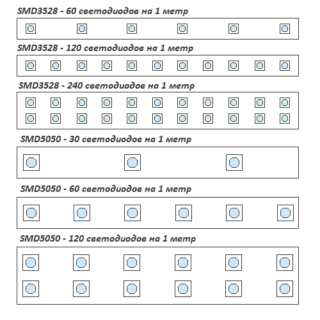
Different types of RZhB backlights differ in size, color, luminous flux from the element and operating voltage. The considered indicators are directly related to the density of the diodes on the surface of the ribbon, which is calculated based on their number per running meter. This parameter is very important during operation, since with their lack it is difficult to obtain the desired level of illumination and its uniformity. Too many dots will give the ribbon the appearance of a continuous shapeless luminous segment.The degree of protection of products is important from the point of view of their operational reliability, which is paid special attention to when installing in the open air.
Varieties of food
Power supply of multicolor tapes can be organized both directly from the 220 Volt network, and from rectified 12, 24 or 36 Volts. The first option applies only to those brands of fixtures that are designed for mains voltage. In the second case, they are connected through additional devices (drivers) that provide the required voltage and limit the current in the circuit.
Control methods
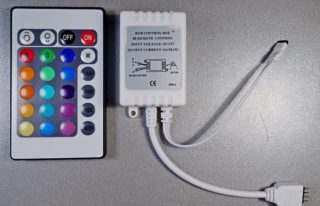
To control the parameters of the multicolor stripe, you will need a special controller. The choice of a particular type of device is determined by the following factors:
- power calculated taking into account the total number of LED elements connected to the controller;
- a set of intended functions, depending on the specific purpose of the backlight;
- possibility of remote control.
Sometimes, in order to save money, it is wiser to choose a not very powerful RGB controller with a special repeater that allows you to expand the load range. This is especially convenient in cases where the total power of the strip LEDs exceeds the capabilities of the control device.
Since there are a lot of applications for these products (including lighting shop windows or lighting aquariums), the need for additional functionality does not always arise. In the above cases, you do not need a controller with a large number of lighting effects or with timer switching, for example.
LED interior lighting with a remote control looks very impressive. An even more original option is the possibility of radio control of the system.
Advantages and disadvantages
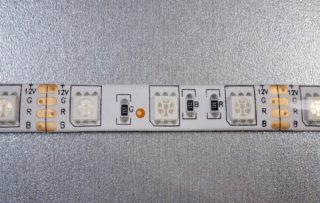
The advantages of LED strip lights include:
- versatility of application;
- low power consumption;
- ease of installation;
- admissibility of forming segments of any length;
- the possibility of obtaining shades (blue, for example);
- if there is a controller, it is permissible to control RGB LEDs (more precisely, the ability to create color effects).
The safety of operation of the illuminators connected to a power supply unit with voltages of 12-36 Volts is also noted.
Among the disadvantages of the products, their high cost is noted, caused by the need for additional control modules - drivers.
Types and modes of operation of controllers
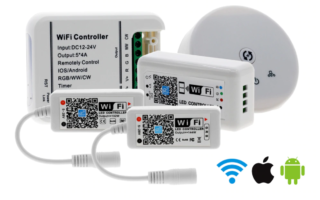
The type of the selected controller is determined by the functionality that is supposed to be implemented in a particular situation. The simplest devices are only capable of choosing a given color and adjusting simple lighting effects. In more "advanced" models, there is a programming function for changing colors and additional effects. They have a connector for flash memory, and are also capable of responding to indoor and outdoor illumination. You can get acquainted with the full functionality in the user manual.
A type of bluetooth controller is known that allows you to control the LED strip using the remote control. Some samples are able to connect to the "smart home" system. The LEDs in the illuminator are usually of the simplest design: for the dynamism of their glow, it is enough to change the value of the supply voltage along the entire length of the tape. In expensive products, they are controlled by digital systems acting on each diode separately. According to these options, the controllers are capable of operating in two modes: analog and digital.
To connect RGB tapes, special connectors are usually used, and in their absence, the soldering method is used.








